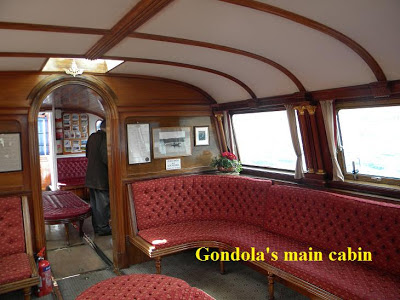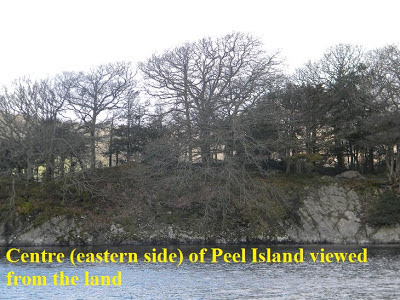As they passed the second cape beyond Darien, Roger, the
look-out, reported a ship, and pointed towards the shore. The sail was on that side, so that Roger saw
it before the others. In the bay beyond
the cape lay a strange-looking dark blue vessel. She was a long narrow craft with a high
raised cabin roof, and a row of glass windows along her side. Her bows were like the bows of an old-time
clipper. Her stern was like that of a
steamship. She had nothing that could
properly be called a mast, though there was a little flagstaff, where a mast
might have been, stepped just forward of the glass-windowed cabin. There was an awning over her after-deck, and
under it a big fat man was sitting writing in a deck-chair. The vessel was moored to a large buoy.
“It’s a houseboat,” said John. (Swallows and Amazon. 1930.)
I soon discovered that the village of Coniston was a good
place in which to find lunch, and was having difficulties deciding between the
Church House Inn and the Wilson Arms as both of their menus looked
wonderful. On a cool and blustery day I
reasoned that a hot lunch, preferably close to a fireplace, was a sensible
idea. But as I walked on down the main
street sense turned to sensibility when I saw a sign with the hands of a clock
showing twelve-thirty and the words “S.Y. Gondola sails.” I had read a little about this boat and
immediately abandoned lunch plans and hurried down to the jetty where a long
narrow craft was already making steam.
Within minutes we were chugging along at a comfortable speed southbound
on the lake.
The original steam yacht Gondola was launched in 1859 as
a summer ferry on Coniston, picking up passengers at various jetties and providing
a link to the Furness Railway station in Coniston. For the next sixty-three years, summer after
summer, she made her way up and down the lake.
Then came the First World war and she was taken out of service, only to
return to duties with the peace in 1918.
Gondola was eventually decommissioned in 1936, entering her retirement
as a non-powered houseboat. (In other words the engine was never fired up
again.) But they were neglectful
years. She slowly deteriorated and by
the 1960s had been abandoned at the southern end of Coniston, little more than
a rotting hulk. Then a powerful winter
storm took her from her moorings and she sank in a reed bed. For years only the superstructure was visible
to other boats.
All however was not lost.
Ten years later money was collected to raise her and look at the
possibilities of refurbishing her. It
was decided that although the hull and the engine were beyond salvage, the rest
of the yacht could be restored. To cut a
wonderfully long story short a replacement hull was built by Vickers of
Barrow-in-Furness, and a new engine and boiler followed. The new Gondola was launched on March 25th,
1980, and has remained in service under the flag of the National Trust ever
since.
For the technically leaning among you, Gondola weighs
forty-five tones, is eighty-six feet long, and has a beam of fifteen feet. Her steam engine, now greenly powered by
burning “logs” made from recycled sawdust, can provide a cruising speed of eight
knots with faster bursts if needed. She
carries a crew of three: A Master, a
stoker, and someone who comes around taking large sums of money from the
maximum number of eighty-six passengers that the yacht is licensed to carry.
There were no more than twenty of us afloat that day and
I was glad of my coat as I sat or stood on the fo'c'sle deck. But what a remarkable experience. Our voyage took us over five miles
down the western shore Coniston Water , looped around, and returned up the
eastern bank. There was a running
commentary from the bridge, pointing out places of interest and telling a
little of the history of the area, but it was good-humoured and pleasant. We learned of copper mining and the Romans,
of the species of fish in the lake, of medieval settlements, of Malcolm
Campbell, the artist John Ruskin, the author Beatrice Potter, and that the farm
to the east (Bank Ground farm) was the inspiration for Holly Howe farm in
Ransome’s stories. The hour and more
passed too quickly.
Gondola was a influential part of Ransome’s boyhood
memories when his family would spend long summer seasons on Coniston, and was clearly the
inspiration for the strange-looking dark blue vessel at anchor in Houseboat Bay. (Swallows and Amazons et al.) He recalled those days much later:
… We could look out high above the lake to the pier on
the further side at which the real Gondola called, giving a warning whistle
before it came into view round the trees on the Waterpark promontory. This was a steam vessel, shaped like an
Italian gondola, with a serpent figurehead.
And then:
With the end of each Long Vacation we had to leave
Nibthwaite and go back to Leeds. We
stayed to the last possible day in deepening melancholy. The Gondola did not
run during the winter and old Captain Hamill (who let me, as a very small boy,
steer his noble vessel, standing behind me at the wheel at the top of the long
cabin) performed a rite of his own. When
for the last time of the year the Gondola left the pier that we could see from
the farmhouse windows, he used to sound his whistle, a long last wail of
farewell until he was out of sight. (The Autobiography. 1976.)
I sailed Coniston Water in a piece of floating history, a
relatively unchanged landscape on both sides.
But I wasn’t returning to a rented house in Nibthwaite but to my rented car
in Coniston village, and by now was very hungry. But having spent a princely sum for a kingly
cruise I bought a cheese sandwich and a bottle of water in a Spar convenience
store, and feasted like a pauper, reviewing the photos that I had taken – some
of which I share with you.
That afternoon was my last in the Lakes and I drove away
from Coniston and towards Barrow. Why
Barrow? I had never seen the place and
perhaps needed an infusion of the modern world – which I soon received. Within half an hour I was driving through a
new commercial park with every large retail name under the sun. It felt brash and ugly, but moving on I knew
that the people of the Lake District do not exist in a theme park inspired by
Ransome, Ruskin and Worsdworth. They
depend on a modern economy with all its industrial, hospital and school
facilities, and a constant source of employment. Needless to say I didn’t take any photographs
there. Who is interested in images of
Staples, Tesco’s, Lidl and TK Maxx?
The next day I would pack and drive leisurely to East
Anglia for a reunion with friends, but I had one port of call
before an early dinner. The Red Lion in Lowick
Bridge where Ransome and friends would often drink a pint or two. And it was a good pint served me, sitting
near a coal fire and listening to a friendly group of late afternoon drinkers
at the bar. Sometimes it’s entertaining
to be an anonymous stranger passing through.
Little did they know that I was not actually a tourist but a South Sea
pirate in disguise come to visit Captain Flint.
Arrrgh!












.JPG)

.JPG)
